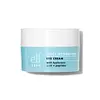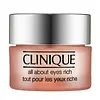What's inside
What's inside
 Key Ingredients
Key Ingredients

 Benefits
Benefits

 Concerns
Concerns

 Ingredients Side-by-side
Ingredients Side-by-side

Water
Skin ConditioningGlycerin
HumectantCaprylic/Capric Triglyceride
MaskingGlyceryl Stearate Citrate
EmollientJojoba Esters
EmollientDiisostearyl Malate
EmollientC10-18 Triglycerides
EmollientCetearyl Alcohol
EmollientSilica
AbrasivePalmitoyl Tripeptide-1
Skin ConditioningPalmitoyl Tetrapeptide-7
Skin ConditioningSoluble Collagen
HumectantSodium Hyaluronate
HumectantTocopherol
AntioxidantHelianthus Annuus Seed Oil
EmollientButylene Glycol
Humectant1,2-Hexanediol
Skin ConditioningPotassium Cetyl Phosphate
EmulsifyingPolysorbate 20
EmulsifyingPolysorbate 80
EmulsifyingIsohexadecane
EmollientSodium Acrylate/Sodium Acryloyldimethyl Taurate Copolymer
Emulsion StabilisingCarbomer
Emulsion StabilisingHydroxyacetophenone
AntioxidantDisodium EDTA
Water, Glycerin, Caprylic/Capric Triglyceride, Glyceryl Stearate Citrate, Jojoba Esters, Diisostearyl Malate, C10-18 Triglycerides, Cetearyl Alcohol, Silica, Palmitoyl Tripeptide-1, Palmitoyl Tetrapeptide-7, Soluble Collagen, Sodium Hyaluronate, Tocopherol, Helianthus Annuus Seed Oil, Butylene Glycol, 1,2-Hexanediol, Potassium Cetyl Phosphate, Polysorbate 20, Polysorbate 80, Isohexadecane, Sodium Acrylate/Sodium Acryloyldimethyl Taurate Copolymer, Carbomer, Hydroxyacetophenone, Disodium EDTA
Water
Skin ConditioningButyrospermum Parkii Butter
Skin ConditioningCetearyl Alcohol
EmollientButylene Glycol
HumectantHydrogenated Polyisobutene
EmollientPhenyl Trimethicone
Skin ConditioningPolyglyceryl-3 Beeswax
EmulsifyingPolybutene
Sucrose
HumectantCetyl Esters
EmollientPolymethyl Methacrylate
Isostearyl Neopentanoate
EmollientGlycerin
HumectantCetearyl Glucoside
EmulsifyingTocopheryl Acetate
AntioxidantTriticum Vulgare Germ Extract
Skin ConditioningHordeum Vulgare Extract
EmollientSigesbeckia Orientalis Extract
Skin ConditioningPEG-100 Stearate
Usnea Barbata Extract
Betula Alba Bud Extract
Skin ConditioningPolysilicone-11
Methyl Glucose Sesquistearate
EmollientCamellia Sinensis Leaf Extract
AntimicrobialSalvia Officinalis Leaf
MaskingGlyceryl Polymethacrylate
Yeast Extract
Skin ConditioningGentiana Lutea Root Extract
Skin ConditioningStearic Acid
CleansingMilk Protein
Skin ConditioningLactis Proteinum
Skin ConditioningPalmitoyl Oligopeptide
CleansingSqualane
EmollientMagnesium Ascorbyl Phosphate
AntioxidantCholesterol
EmollientCaffeine
Skin ConditioningPEG-8
HumectantPhytosphingosine
Skin ConditioningAcrylates/C10-30 Alkyl Acrylate Crosspolymer
Emulsion StabilisingAminomethyl Propanol
BufferingDimethicone
EmollientIsomerized Linoleic Acid
Skin ConditioningLinoleic Acid
CleansingSodium Hyaluronate
Humectant1,2-Hexanediol
Skin ConditioningDecarboxy Carnosine Hcl
Skin ConditioningPotassium Sulfate
Caprylyl Glycol
EmollientDisodium EDTA
Sodium Dehydroacetate
PreservativePhenoxyethanol
PreservativeCI 19140
Cosmetic ColorantMica
Cosmetic ColorantIron Oxides
CI 77891
Cosmetic ColorantWater, Butyrospermum Parkii Butter, Cetearyl Alcohol, Butylene Glycol, Hydrogenated Polyisobutene, Phenyl Trimethicone, Polyglyceryl-3 Beeswax, Polybutene, Sucrose, Cetyl Esters, Polymethyl Methacrylate, Isostearyl Neopentanoate, Glycerin, Cetearyl Glucoside, Tocopheryl Acetate, Triticum Vulgare Germ Extract, Hordeum Vulgare Extract, Sigesbeckia Orientalis Extract, PEG-100 Stearate, Usnea Barbata Extract, Betula Alba Bud Extract, Polysilicone-11, Methyl Glucose Sesquistearate, Camellia Sinensis Leaf Extract, Salvia Officinalis Leaf, Glyceryl Polymethacrylate, Yeast Extract, Gentiana Lutea Root Extract, Stearic Acid, Milk Protein, Lactis Proteinum, Palmitoyl Oligopeptide, Squalane, Magnesium Ascorbyl Phosphate, Cholesterol, Caffeine, PEG-8, Phytosphingosine, Acrylates/C10-30 Alkyl Acrylate Crosspolymer, Aminomethyl Propanol, Dimethicone, Isomerized Linoleic Acid, Linoleic Acid, Sodium Hyaluronate, 1,2-Hexanediol, Decarboxy Carnosine Hcl, Potassium Sulfate, Caprylyl Glycol, Disodium EDTA, Sodium Dehydroacetate, Phenoxyethanol, CI 19140, Mica, Iron Oxides, CI 77891
 Reviews
Reviews

Ingredients Explained
These ingredients are found in both products.
Ingredients higher up in an ingredient list are typically present in a larger amount.
1,2-Hexanediol is a synthetic liquid and another multi-functional powerhouse.
It is a:
- Humectant, drawing moisture into the skin
- Emollient, helping to soften skin
- Solvent, dispersing and stabilizing formulas
- Preservative booster, enhancing the antimicrobial activity of other preservatives
Butylene Glycol (or BG) is used within cosmetic products for a few different reasons:
Overall, Butylene Glycol is a safe and well-rounded ingredient that works well with other ingredients.
Though this ingredient works well with most skin types, some people with sensitive skin may experience a reaction such as allergic rashes, closed comedones, or itchiness.
Learn more about Butylene GlycolCetearyl alcohol is a mixture of two fatty alcohols: cetyl alcohol and stearyl alcohol. It is mainly used as an emulsifier. Emulsifiers help prevent the separation of oils and products. Due to its composition, it can also be used to thicken a product or help create foam.
Cetearyl alcohol is an emollient. Emollients help soothe and hydrate the skin by trapping moisture.
Studies show Cetearyl alcohol is non-toxic and non-irritating. The FDA allows products labeled "alcohol-free" to have fatty alcohols.
This ingredient is usually derived from plant oils such as palm, vegetable, or coconut oils. There is debate on whether this ingredient will cause acne.
Due to the fatty acid base, this ingredient may not be Malassezia folliculitis safe.
Learn more about Cetearyl AlcoholDisodium EDTA plays a role in making products more stable by aiding other preservatives.
It is a chelating agent, meaning it neutralizes metal ions that may be found in a product.
Disodium EDTA is a salt of edetic acid and is found to be safe in cosmetic ingredients.
Learn more about Disodium EDTAGlycerin is already naturally found in your skin. It helps moisturize and protect your skin.
A study from 2016 found glycerin to be more effective as a humectant than AHAs and hyaluronic acid.
As a humectant, it helps the skin stay hydrated by pulling moisture to your skin. The low molecular weight of glycerin allows it to pull moisture into the deeper layers of your skin.
Hydrated skin improves your skin barrier; Your skin barrier helps protect against irritants and bacteria.
Glycerin has also been found to have antimicrobial and antiviral properties. Due to these properties, glycerin is often used in wound and burn treatments.
In cosmetics, glycerin is usually derived from plants such as soybean or palm. However, it can also be sourced from animals, such as tallow or animal fat.
This ingredient is organic, colorless, odorless, and non-toxic.
Glycerin is the name for this ingredient in American English. British English uses Glycerol/Glycerine.
Learn more about GlycerinSodium Hyaluronate is hyaluronic acid's salt form. It is commonly derived from the sodium salt of hyaluronic acid.
Like hyaluronic acid, it is great at holding water and acts as a humectant. This makes it a great skin hydrating ingredient.
Sodium Hyaluronate is naturally occurring in our bodies and is mostly found in eye fluid and joints.
These are some other common types of Hyaluronic Acid:
Learn more about Sodium HyaluronateWater. It's the most common cosmetic ingredient of all. You'll usually see it at the top of ingredient lists, meaning that it makes up the largest part of the product.
So why is it so popular? Water most often acts as a solvent - this means that it helps dissolve other ingredients into the formulation.
You'll also recognize water as that liquid we all need to stay alive. If you see this, drink a glass of water. Stay hydrated!
Learn more about Water